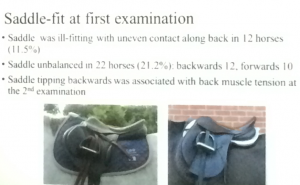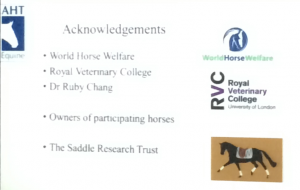This was a Longitudinal study over 1 year.
[There are lots of fascinating conclusions to this study. It really is worth wading through it all, I promise!]
 Objectives: To investigate changes in back dimensions over time in sports horses of variable age, from a range of work disciplines, working at different levels.
Objectives: To investigate changes in back dimensions over time in sports horses of variable age, from a range of work disciplines, working at different levels.
To quantify changes in back dimensions and determine the influence of horse-saddle-rider data and the association with season, weight, work and saddle management changes.
A recent survey demonstrated that saddle fit was checked annually in only 31% of horses & more than once yearly in only 12% of horses. (Greve and Dyson, Equine Vet J)
There is no objective data evaluating changes in back dimensions over time.
Knowledge about how back dimensions may change over time is important to determine how often saddle-fit should be checked.
Bear in mind the huge influence saddle fit can have on comfort and performance.
Baseline horse data was recorded:
Age, breed, gender, height, estimated body weight (weight tape) and body condition score (BCS) (1-9).
Work discipline and work level.
104 sports horses in normal work (4 disciplines: Dr, SJ, Eventing, GP) were monitored prospectively, in 4 age groups: 3-5yrs, 6-8yrs, 9-12yrs, 13 and up. (Numbers fell over the year, due to horses being sold, euthanised, etc, but a meaningful number still remained at the end.)
Time Variant Variables:
Professionally assisted saddle fit
Maintaining or increasing work level or intensity
Season
Increase or decrease in horse body weight
Time Invariant Variables:
Lameness – they had less shape changes compared with sounder horses
Minor Back Asymmetries – less width change than symmetrical horses
Horse weight / rider weight – the lighter the rider relative to the horse’s weight, the greater the changes
Base line data: dynamic examination.
line data: dynamic examination.
Every horse was worked in the same way: 30 minutes of their rider’s regular work with them, based on their stage of training and work discipline.
Video recordings were taken near the end of the session, all horses doing working trot (straight lines and circles of 20m and 10m on both reins) and working canter (straight lines and 20m circles.)
Video recordings were assessed by both authors by consensus.
Measurements were always taken by the same person, with the horse standing square on hard level ground.

They measured whether the saddle moved to 1 side, whether it stayed behind the scapulae, any abnormal movement of the saddle from side to side.
Show-jumpers tended to have 1 saddle between 3 horses, other disciplines usually had 1 saddle per horse.
Overall, show-jumpers showed significantly fewer mean width changes (at positions T8 and T13 of the back) over the year compared to horses from other disciplines.
There was NO difference in back width (or shape) ratio changes among age groups, irrespective of discipline.
There were May and September peaks in width change. Peak changes in late spring and negative changes in January, a reflection of the nutritional value of pasture.
 Seasonal fluctuations in the cranial saddle region were markedly influenced by professionally-assisted saddle fit. If the saddle did not fit, these changes did not occur or were negative.
Seasonal fluctuations in the cranial saddle region were markedly influenced by professionally-assisted saddle fit. If the saddle did not fit, these changes did not occur or were negative.
The saddle tipping backwards is associated with back tension.
Lameness:
64% were sound.
There was a greater mean back width change in sound horses.
21 out of 88 saddles were moving abnormally.
14% of riders were crooked.
CONCLUSIONS.
 Mean changes were greater at T13 point of the back under expert riders.
Mean changes were greater at T13 point of the back under expert riders.
In final model, professionally-assisted saddle fit and rider bodyweight retained significance, whereas rider skill level did not.
Position and balance of rider were influenced by skill-level, fit of saddle to horse and fit of saddle to rider.
A well-fitted saddle with a heavy rider in balance may be less detrimental than a lighter rider who is not in balance.
Rider’s weight and saddle fit were significant, NOT rider experience (expert-ness of the rider).
Magnitude of forces applied to horse’s back increase with rider’s bodyweight and acceleration.
Focal concentration of force with badly fitting saddle was of greater concern with heavier rider.
Poor saddle fit may impair structural development.
Clinical observation that horses’ back shapes can change rapidly over time.
This is already recognised by the saddle fitting industry.
Show-jumpers:
Showed fewer back dimension changes & greater frequency of back asymmetries.
Same saddle used on multiple horses
Additional pads and numnahs in an attempt to improve saddle fit.
Is it also related to the way showjumpers are worked – quality and quantity?
Reduced movement may limit back development and lead to muscle wasting away.
So, how often should saddle-fit be assessed?
Saddle fit was hugely influential in changes in back dimensions over a year, especially in young horses or in association with a change in work level or nutrition.
Saddle fit is the NUMBER ONE EFFECT on change in shape. It should be checked several times a year.
Recommendations:
Early recognition of an ill-fitting saddle may reduce the risk of compromised back movement, development of back pain, failure of muscle development, or muscle atrophy, and deterioration in performance because of back pain.
The Back
(muscle development &/or pain) is a very sensitive indicator of:
Saddle fit
Rider position in / not in balance Quality of work
The presence of underlying pain due to lameness, sacroiliac or thoracolumbular-sacral pain
Books mentioned: “Pain Free Saddle Fit” and “Suffering in Silence”.
Approximately 1/3 of horses (presumably fitted by Pro saddle fitters) had, in her opinion, badly fitting saddles.
Horse’s back health is a very good reflector of the rest of the horse’s musco-skeletal system.
Quantifiable changes in back dimensions occur throughout the year and within 2 months, the speed and direction of which are influenced by saddle-fit, season, bodyweight, rider bodyweight and work history and work level.
Saddle fit should be reassessed professionally several times a year, especially if there has been a change in work intensity.
Poor saddle-fit can potentially inhibit muscle development.
Sue Dyson on saddle fitters: “We do not have enough people who are good at the job.”







Could you tell me where I can find the research please?
Kathy, the links are all from this page:
http://saddleresearchtrust.com/research.html
Hope that helps.
The issue is finding a professinal saddler fitter than can actually fit well. They are few and far between.